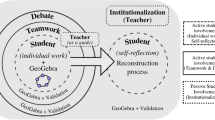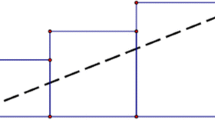Abstract
The purpose of this study is to examine the effect of a technology-enhanced collaborative learning environment on secondary school students’ mathematical reasoning in the concept of triangle. The participants of the study are 30 secondary school students. This study was carried out with the embedded design, one of the mixed methods designs. The quantitative aspect of the study was carried out with the quasi-experimental design including comparison group design. While the experimental group received training in a technology-enhanced collaborative learning environment, the control group students continued their education in a traditional informal-collaborative learning environment. The qualitative aspect of the study included data belonging to a group of four students chosen among the experimental group. The data of the research comprised students’ audio and video recordings, screenshots, dynamic mathematics software GeoGebra files, and written products. The quantitative data were collected via open-ended questions including ten items with the intention of revealing mathematical reasoning and the qualitative data were gathered with the designed mathematical tasks. While independent t-test was used to analyse the quantitative data, the qualitative data were analysed with Toulmin’s model and dialogical approach. As a result of data analysis, it was found that technology-enhanced collaborative learning environment has a positive effect on students’ mathematical reasoning in the concept of triangle.
















Similar content being viewed by others
Data availability statements
The datasets generated during and analyzed during the current study are available from the corresponding author on reasonable request.
References
Aksu, N., & Zengin, Y. (2022). Disclosure of students’ mathematical reasoning through collaborative technology-enhanced learning environment. Education and Information Technologies, 27(2), 1609–1634. https://doi.org/10.1007/s10639-021-10686-x
Balacheff, N. (1991). Benefits and limits of social interaction: The case of mathematical proof. In A. J. Bishop, S. Mellin-Olsen, & J. Van Dormolen (Eds.), Mathematical Knowledge: Its Growth Through Teaching (pp. 175–192). Kluwer Academic Publishers.
Bjuland, R., LuizaCestari, M., & Borgersen, H. E. (2008). The interplay between gesture and discourse as mediating devices in collaborative mathematical reasoning: A multimodal approach. Mathematical Thinking and Learning, 10(3), 271–292. https://doi.org/10.1080/10986060802216169
Brodie, K. (2010). Teaching mathematical reasoning in secondary school classrooms. Springer. https://doi.org/10.1007/978-0-387-09742-8
Cantürk-Günhan, B. (2014). A case study on the investigation of reasoning skills in geometry. South African Journal of Education, 34(2), 1–19. https://doi.org/10.15700/201412071156
Carlsen, M. (2018). Upper secondary students’ mathematical reasoning on a sinusoidal function. Educational Studies in Mathematics, 99(3), 277–291. https://doi.org/10.1007/s10649-018-9844-1
Conner, A., Singletary, L. M., Smith, R. C., Wagner, P. A., & Francisco, R. T. (2014). Identifying kinds of reasoning in collective argumentation. Mathematical Thinking and Learning, 16(3), 181–200. https://doi.org/10.1080/10986065.2014.921131
Creswell, J. W., & Plano Clark, V. L. (2017). Designing and conducting mixed methods research (3rd ed.). SAGE Publications.
Demir, M., Zengin, Y., Özcan, Ş., Urhan, S., & Aksu N. (2022). Students’ mathematical reasoning on the area of the circle: 5E-based flipped classroom approach. International Journal of Mathematical Education in Science and Technology, 1-25. https://doi.org/10.1080/0020739X.2022.2101955
Dikovic, L. (2009). Implementing dynamic mathematics resources with GeoGebra at the college level. International Journal of Emerging Technologies in Learning (iJET), 4(3), 51–54. https://doi.org/10.3991/ijet.v4i3.784
Erkek, Ö., & Işıksal-Bostan, M. (2015). Is the use of GeoGebra advantageous in the process of argumentation? In CERME 9-Ninth Congress of the European Society for Research in Mathematics Education (pp. 121–127).
Fraenkel, J. R., & Wallen, N. E. (2012). How to design and evaluate research in education (7th ed.). McGraw-Hill.
Hitt, F. (2006). Students’ functional representations and conceptions in the construction of mathematical concepts. An example: The concept of limit. In Annales de didactique et de sciences cognitives (vol. 11, pp. 253–268).
Hitt, F. (2011). Construction of mathematical knowledge using graphic calculators (CAS) in the mathematics classroom. International Journal of Mathematical Education in Science and Technology, 42(6), 723–735. https://doi.org/10.1080/0020739X.2011.583364
Hitt, F., & González-Martín, A. S. (2015). Covariation between variables in a modelling process: The ACODESA (collaborative learning, scientific debate and self-reflection) method. Educational Studies in Mathematics, 88(2), 201–219. https://doi.org/10.1007/s10649-014-9578-7
Hitt, F., & Kieran, C. (2009). Constructing knowledge via a peer interaction in a CAS environment with tasks designed from a task–technique–theory perspective. International Journal of Computers for Mathematical Learning, 14(2), 121–152. https://doi.org/10.1007/s10758-009-9151-0
Hitt, F., Saboya, M., & Cortés, C. (2017). Task design in a paper and pencil and technological environment to promote inclusive learning: An example with polygonal numbers. In Mathematics and technology (pp. 57–74). Springer, Cham.
Hohenwarter, M., & Fuchs, K. (2004). Combination of dynamic geometry, algebra and calculus in the software system GeoGebra. [Paper presentation]. Computer Algebra Systems and Dynamic Geometry Systems in Mathematics Teaching Conference, Pecs, Hungary
Jeannotte, D., & Kieran, C. (2017). A conceptual model of mathematical reasoning for school mathematics. Educational Studies in Mathematics, 96(1), 1–16. https://doi.org/10.1007/s10649-017-9761-8
Kovács, Z., Recio, T., Richard, P. R., Van Vaerenbergh, S., & Vélez, M. P. (2022). Towards an ecosystem for computer-supported geometric reasoning. International Journal of Mathematical Education in Science and Technology, 53(7), 1701–1710. https://doi.org/10.1080/0020739X.2020.1837400
Linell, P. (1998). Approaching dialogue: Talk, interaction and contexts in dialogical perspectives. John Benjamins Publishing Company.
Mercer, N., Wegerif, R., & Dawes, L. (1999). Children’s talk and the development of reasoning in the classroom. British Educational Research Journal, 25(1), 95–111. https://doi.org/10.1080/0141192990250107
National Council of Teachers of Mathematics. (2000). Principles and standards for school mathematics. NCTM.
Pedemonte, B. (2007). How can the relationship between argumentation and proof be analysed? Educational Studies in Mathematics, 66(1), 23–41. https://doi.org/10.1007/s10649-006-9057-x
Pedemonte, B., & Balacheff, N. (2016). Establishing links between conceptions, argumentation and proof through the ck¢-enriched Toulmin model. The Journal of Mathematical Behavior, 41, 104–122. https://doi.org/10.1016/j.jmathb.2015.10.008
Poon, K. K., & Leung, C. K. (2016). A study of geometric understanding via logical reasoning in Hong Kong. International Journal for Mathematics Teaching and Learning, 17(3), 1–31.
Preiner, J. (2008). Introducing Dynamics Mathematics Software to Mathematics Teacher: The Case of GeoGebra. Dissertation in Mathematics Education, University of Salzburg.
Radford, L. (2003). Gestures, speech, and the sprouting of signs: A semiotic-cultural approach to students’ types of generalization. Mathematical Thinking and Learning, 5(1), 37–70. https://doi.org/10.1207/S15327833MTL0501_02
Santos-Trigo, M., & Reyes-Rodriguez, A. (2016). The use of digital technology in finding multiple paths to solve and extend an equilateral triangle task. International Journal of Mathematical Education in Science and Technology, 47(1), 58–81. https://doi.org/10.1080/0020739X.2015.1049228
Sfard, A. (2008). Thinking as communicating: Human development, the growth of discourses, and mathematizing. Cambridge University Press.
Sumarsih, Budiyono, & Indriati, D. (2018). Profile of mathematical reasoning ability of 8thgrade students seen from communicational ability, basic skills, connection, and logical thinking. In Journal of Physics: Conference Series (vol. 1008, no. 1, p. 012078). IOP Publishing.
Takači, D., Stankov, G., & Milanovic, I. (2015). Efficiency of learning environment using GeoGebra when calculus contents are learned in collaborative groups. Computers & Education, 82, 421–431. https://doi.org/10.1016/j.compedu.2014.12.002
Tong, D. H., Uyen, B. P., & Quoc, N. V. A. (2021). The improvement of 10th students’ mathematical communication skills through learning ellipse topics. Heliyon, 7(11), e08282.
Toulmin, S. E. (2003). The uses of argument. Cambridge University Press.
Trocki, A., & Hollebrands, K. (2018). The development of a framework for assessing dynamic geometry task quality. Digital Experiences in Mathematics Education, 4(2), 110–138. https://doi.org/10.1007/s40751-018-0041-8
Turgut, M. (2022). Reinventing geometric linear transformations in a dynamic geometry environment: Multimodal analysis of student reasoning. International Journal of Science and Mathematics Education, 20(6), 1203–1223. https://doi.org/10.1007/s10763-021-10185-y
Ubah, I., & Bansilal, S. (2019). The use of semiotic representations in reasoning about similar triangles in Euclidean geometry. Pythagoras, 40(1), 1–10.
Urhan, S. (2022). Using Habermas’ construct of rationality to analyze students’ computational thinking: The case of series and vector. Education and Information Technologies, 1–80. https://doi.org/10.1007/s10639-022-11002-x
Wood, T. (1999). Creating a context for argument in mathematics class. Journal for Research in Mathematics Education, 30(2), 171–191. https://doi.org/10.2307/749609
Zembat, I. O. (2008). Pre-service teachers’ use of different types of mathematical reasoning in paper-and-pencil versus technology-supported environments. International Journal of Mathematical Education in Science and Technology, 39(2), 143–160. https://doi.org/10.1080/00207390701828705
Zengin, Y. (2018a). Examination of the constructed dynamic bridge between the concepts of differential and derivative with the integration of GeoGebra and the ACODESA method. Educational Studies in Mathematics, 99(3), 311–333. https://doi.org/10.1007/s10649-018-9832-5
Zengin, Y. (2018b). Incorporating the dynamic mathematics software GeoGebra into a history of mathematics course. International Journal of Mathematical Education in Science and Technology, 49(7), 1083–1098. https://doi.org/10.1080/0020739X.2018.1431850
Zengin, Y. (2021). Students’ understanding of parametric equations in a collaborative technology-enhanced learning environment. International Journal of Mathematical Education in Science and Technology, 1–27. Advance online publication. https://doi.org/10.1080/0020739X.2021.1966848
Zengin, Y. (2022). Construction of proof of the Fundamental Theorem of Calculus using dynamic mathematics software in the calculus classroom. Education and Information Technologies, 27(2), 2331–2366. https://doi.org/10.1007/s10639-021-10666-1
Acknowledgements
We are grateful to the editors and anonymous reviewers for their valuable comments on this paper. In addition, this paper is based on the part of main results implemented within the context of the first author’s master thesis.
Author information
Authors and Affiliations
Corresponding author
Ethics declarations
Ethical approval
All procedures performed in studies involving human participants were in accordance with the ethical standards. The ethical committee approval for this study was obtained from the Social Sciences Ethics Committee at Dicle University (Approval Number is 2022/02/21–236536).
Informed consent
The data was completed voluntarily and anonymously.
Conflict of interest
The authors declare no conflicts of interest.
Additional information
Publisher's note
Springer Nature remains neutral with regard to jurisdictional claims in published maps and institutional affiliations.
Appendices
Appendix 1. Task 1
Cem carried out his fourth construction project on an equilateral triangle shaped plot. Answer the following questions
-
1.
Two cars move at the same time from each apartment with a constant velocity. Which vehicle arrives at the exit point first? Why?
-
2.
Discuss the cars’ arrival time to the exit point with your peers. Build a collective argument with justifies.
-
3.
Using the GeoGebra software, draw a sketch showing the residential area in this project. What is the relationship between the length of the roads that provide access from the entrance points of the residential area to the apartment building? Discuss it by make a conjecture.
-
4.
By dragging, analyse whether or not the situation you have noticed is valid for any equilateral triangle. Explain the result you have reached.
-
5.
Explain the relationship between the length of the medians in an equilateral triangle based on your conjectures and observations.
Appendix 2. Task 2
There is a sketch of a plot on the paper in Cem’s hand. This plot is like a right-angled triangle. Cem will temporarily locate his office in a place at the same distance from each building. Answer the following questions.
-
1.
Show the location where the office should be placed by drawing. Explain why you chose this point.
-
2.
Compare your drawing by sharing it with your peers. Make explanations that will justify you.
-
3.
Use the GeoGebra software to find where Cem’s office should be located. How would you explain that this point is the right point?
-
4.
What does the point you have found correspond to in any right-angled triangle?
-
5.
By dragging, examine whether or not this point provides the same properties of any right-angled triangle. Explain the result you have reached.
Appendix 3: An example question included in reasoning test

Rights and permissions
Springer Nature or its licensor (e.g. a society or other partner) holds exclusive rights to this article under a publishing agreement with the author(s) or other rightsholder(s); author self-archiving of the accepted manuscript version of this article is solely governed by the terms of such publishing agreement and applicable law.
About this article
Cite this article
Demir, M., Zengin, Y. The effect of a technology-enhanced collaborative learning environment on secondary school students’ mathematical reasoning: A mixed method design. Educ Inf Technol 28, 9855–9883 (2023). https://doi.org/10.1007/s10639-023-11587-x
Received:
Accepted:
Published:
Issue Date:
DOI: https://doi.org/10.1007/s10639-023-11587-x




